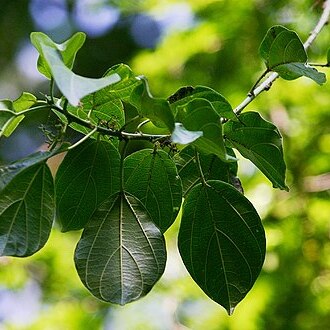Robust climber, sometimes creeping among rocks. Stems softly woody, with wide spongy pith or hollow in centre, with large leaf scars on young branches, up to 100 mm in diameter at base. Bark longitudinally striate, brown to purplish. Leaves elliptic to very broadly elliptic, 63-120 x 40-65 mm, apex acute to long-or short-attenuate, base cuneate, truncate or slightly cordate, margin entire, main veins prominent, side veins scalariform, glabrous, often discolorous; petiole 20-50 mm long, glabrous or with a few large stinging hairs, often mounted on protuberances; stipules early caducous, ±7 mm long. Female inflorescence lax, paniculate, ±20 mm long, with small cymose clusters of flowers; peduncle with a few stinging hairs. Male inflorescence lax, paniculate, ±65 mm long, with flowers densely clustered at intervals along axes and branches of inflorescence; peduncle mostly with a few stinging hairs. Female flowers sessile; perianth cylindrical, with constriction at apex, with 4 blunt but clearly marked teeth, glabrous, ±1 mm long. Male flowers on pedicels up to 1 mm long, glabrous, ±1.75 mm in diameter. Achenes glabrous, 1.5-2.0 mm long, without markings, enclosed in persisting, accrescent, fleshy, orange perianth.
Leaves (4)6–12 x 3.5–8 cm., elliptic to ovate, rarely obovate; apex acuminate to caudate; base cuneate, truncate or rounded, rarely subcordate; margin entire; lamina coriaceous, upper surface glabrous, rarely with a few scattered stiff hairs, numerous elongated cystoliths present, lower surface glabrous, occasionally pubescent or with scattered, stiff and perhaps stinging hairs, especially on the lateral nerves, rarely with stinging hairs on raised protuberances up to 0.8 mm. high; lateral nerves 2–3(4) pairs, the basal pair extending into upper third of lamina, all interconnected by scalariform-tertiary nerves.
Perennial climber, 3-10 m high. Leaves alternate, elliptic to ovate, glabrous above, elongated cystoliths present, pubescent or scattered hairs below, base cuneate or slightly cordate, margins entire; petioles up to 50 mm long; stipules brown, ± 10 mm long. Inflorescence lax, paniculate; peduncle with stinging hairs. Flowers unisexual. Male flowers on pedicels ± 1 mm long, glabrous, 4-merous, up to 1.75 mm in diam. Female flowers sessile; tepals 4, perianth cylindrical, ± 1 mm long. Flowering time Oct., Nov. Fruit an achene, ± 2 mm long, enclosed in fleshy, orange perianth, stipitate.
A soft scrambling shrub. It can be 3 m tall. It can occur in the canopy in evergreen forest. The bark is brown or greenish. The leaves are oval or heart shaped. They are 12 cm long by 6 cm wide. The surface of the leaf has a textured feel. There are 3 veins from the base. The edge of the leaf is wavy. The flowers are of separate sexes on separate plants. They are small and greenish-white. They occur in small branched sprays in the axils of leaves. The fruit are small nuts.
Male inflorescences lax, paniculate, c. 6.5 cm. long, with flowers densely clustered at intervals along the axes; peduncle mostly with a few stinging hairs; female inflorescence lax, paniculate, c. 2 cm. long, with a small cymose cluster of flowers, peduncle with stinging hairs, especially around the cluster of flowers.
Stems softly woody, up to 10 cm. in diam. at base; bark grey to brownish-black, longitudinally striate, glabrous, rarely pubescent, with large leaf scars on young branches but very rarely with raised protuberances; sap copious, clear; pith wide, spongy, or stems hollow in centre.
Petioles 2.5–6 cm. long, glabrous to pubescent, rarely with a few stinging hairs, which are sessile or raised on protuberances up to 0.5 mm. high.
Female flowers sessile; perianth 1–1.5 mm. long, cylindrical, constricted at apex, with 4 blunt but clearly marked teeth, glabrous.
Stipules brown, fused almost to the apex, 6–10 mm. long, pubescent on the midnerves to subsericeous outside, glabrous inside.
Achene glabrous, 1.5–2 mm. long, without markings, enclosed in the persistent, accrescent, fleshy, orange perianth.
Male flowers on pedicels up to 1 mm. long, 4-merous, glabrous, perianth 1–1.75 mm. in diam.
Liana, climbing to 10 m. or more.

